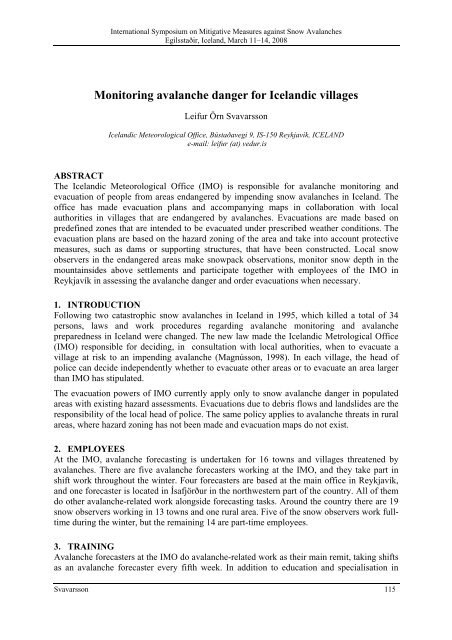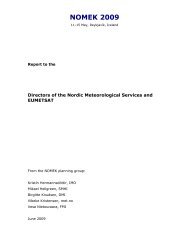International Symposium on Mitigative Measures against Snow ...
International Symposium on Mitigative Measures against Snow ...
International Symposium on Mitigative Measures against Snow ...
You also want an ePaper? Increase the reach of your titles
YUMPU automatically turns print PDFs into web optimized ePapers that Google loves.
<str<strong>on</strong>g>Internati<strong>on</strong>al</str<strong>on</strong>g> <str<strong>on</strong>g>Symposium</str<strong>on</strong>g> <strong>on</strong> <strong>Mitigative</strong> <strong>Measures</strong> <strong>against</strong> <strong>Snow</strong> Avalanches<br />
Egilsstaðir, Iceland, March 11–14, 2008<br />
M<strong>on</strong>itoring avalanche danger for Icelandic villages<br />
Leifur Örn Svavarss<strong>on</strong><br />
Icelandic Meteorological Office, Bústaðavegi 9, IS-150 Reykjavík, ICELAND<br />
e-mail: leifur (at) vedur.is<br />
ABSTRACT<br />
The Icelandic Meteorological Office (IMO) is resp<strong>on</strong>sible for avalanche m<strong>on</strong>itoring and<br />
evacuati<strong>on</strong> of people from areas endangered by impending snow avalanches in Iceland. The<br />
office has made evacuati<strong>on</strong> plans and accompanying maps in collaborati<strong>on</strong> with local<br />
authorities in villages that are endangered by avalanches. Evacuati<strong>on</strong>s are made based <strong>on</strong><br />
predefined z<strong>on</strong>es that are intended to be evacuated under prescribed weather c<strong>on</strong>diti<strong>on</strong>s. The<br />
evacuati<strong>on</strong> plans are based <strong>on</strong> the hazard z<strong>on</strong>ing of the area and take into account protective<br />
measures, such as dams or supporting structures, that have been c<strong>on</strong>structed. Local snow<br />
observers in the endangered areas make snowpack observati<strong>on</strong>s, m<strong>on</strong>itor snow depth in the<br />
mountainsides above settlements and participate together with employees of the IMO in<br />
Reykjavík in assessing the avalanche danger and order evacuati<strong>on</strong>s when necessary.<br />
1. INTRODUCTION<br />
Following two catastrophic snow avalanches in Iceland in 1995, which killed a total of 34<br />
pers<strong>on</strong>s, laws and work procedures regarding avalanche m<strong>on</strong>itoring and avalanche<br />
preparedness in Iceland were changed. The new law made the Icelandic Metrological Office<br />
(IMO) resp<strong>on</strong>sible for deciding, in c<strong>on</strong>sultati<strong>on</strong> with local authorities, when to evacuate a<br />
village at risk to an impending avalanche (Magnúss<strong>on</strong>, 1998). In each village, the head of<br />
police can decide independently whether to evacuate other areas or to evacuate an area larger<br />
than IMO has stipulated.<br />
The evacuati<strong>on</strong> powers of IMO currently apply <strong>on</strong>ly to snow avalanche danger in populated<br />
areas with existing hazard assessments. Evacuati<strong>on</strong>s due to debris flows and landslides are the<br />
resp<strong>on</strong>sibility of the local head of police. The same policy applies to avalanche threats in rural<br />
areas, where hazard z<strong>on</strong>ing has not been made and evacuati<strong>on</strong> maps do not exist.<br />
2. EMPLOYEES<br />
At the IMO, avalanche forecasting is undertaken for 16 towns and villages threatened by<br />
avalanches. There are five avalanche forecasters working at the IMO, and they take part in<br />
shift work throughout the winter. Four forecasters are based at the main office in Reykjavík,<br />
and <strong>on</strong>e forecaster is located in Ísafjörður in the northwestern part of the country. All of them<br />
do other avalanche-related work al<strong>on</strong>gside forecasting tasks. Around the country there are 19<br />
snow observers working in 13 towns and <strong>on</strong>e rural area. Five of the snow observers work fulltime<br />
during the winter, but the remaining 14 are part-time employees.<br />
3. TRAINING<br />
Avalanche forecasters at the IMO do avalanche-related work as their main remit, taking shifts<br />
as an avalanche forecaster every fifth week. In additi<strong>on</strong> to educati<strong>on</strong> and specialisati<strong>on</strong> in<br />
Svavarss<strong>on</strong> 115











